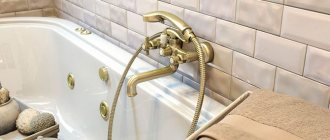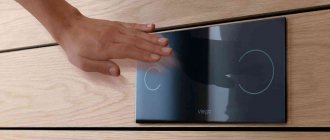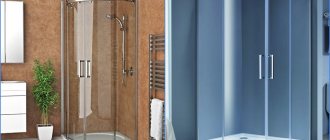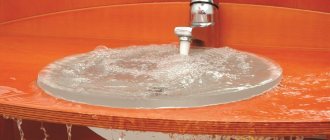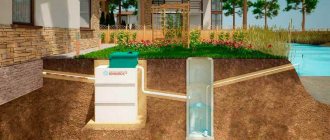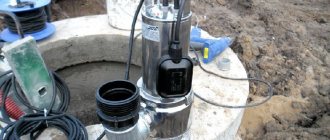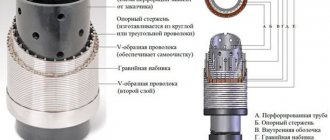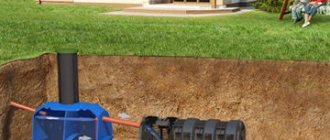Color, installation method, type of outlet, bowl shape, execution style, reliability of the flush mechanism - these are the main criteria that, in addition to cost, the buyer of a toilet pays attention to. But it is difficult to assess how comfortable it will be to use this plumbing fixture. And whether this toilet provides anti-splash, most simply take it on faith from the seller’s words. But this property also has visible signs, although they may differ for different bowl shapes.
In Soviet times, almost all domestic toilets had “anti-splash”. More precisely, there was a splash, but it was completely insignificant, and rarely did the splashes from the fall of “solid” waste products reach the toilet seat. This was achieved without any system, but simply due to the dish-shaped shape of the bowl.
The horizontal shelf between the water outlet and the hole in the water lock looked like a shallow “plate”; there was little water in it, and the distance from the seat plane to the bottom was insignificant. Therefore, when the “solid” waste fell, the splash was weak.
You can, of course, be content with this choice, but products with shelves have significant drawbacks. That’s why they came up with a toilet with an anti-splash system, which is devoid of these shortcomings.
Popular models
Many brands are producing toilets with an anti-splash option.
Domestic plumbing costs less than imported ones. But in the ranking of the best manufacturers, it is foreign companies that lead. Porcelain toilets with a splash suppression function are produced by the Italian company BelBagno Alpina. This manufacturer offers models with installation, wall-hung sanitary ware and classic floor-standing ones. All products are of high quality and designed for long-term use.
The leader in the ranking of the best anti-splash plumbing fixtures is Ifo Frisk RS021030000. This is sanitary equipment from a Swiss manufacturer, equipped with a microlift, coated with antibacterial enamel. The toilet has an oval-shaped bowl and a double flush system. Its weight is 30 kg. The ceramic product is guaranteed for a period of 10 years. Water is drawn into the tank silently; fastenings are included in the package.
The design of the toilet is made in high-tech style; it will fit perfectly into a modern interior.
AM. RM joi C858607SC is a floor-standing toilet from a German manufacturer. It has a snow-white oval bowl and a half-hidden direct outlet. The laconic design of the sanitary ware allows you to emphasize the cleanliness of the bathrooms. Other features of this model include the presence of a microlift and double flush. The cost of such toilets starts from 10 thousand rubles, their installation is carried out hidden.
Among domestic manufacturers, it is worth highlighting the Sanita Standard brand. The line of toilets of this brand includes several models with “anti-splash”.
Smart toilets
Manufacturers of sanitary equipment try to use the most modern technologies in the production process so that toilets meet all sanitary and aesthetic requirements. Constant development has led to the creation of a “smart toilet”, in the overall system of which various technical solutions are integrated and introduced for more comfortable use of the toilet.
One of the representatives of smart plumbing can be called toilets with a bidet function. When using such products, the need to use paper is completely eliminated due to the ability to wash away after bowel movements.
Auto-flush toilets are also advanced products. Such plumbing is simply necessary for people who constantly forget to press the drain button or for those who love perfect cleanliness.
Toilets equipped with a heated seat are more useful for women, especially in the cold season. Heating can work continuously or turn on when using the toilet.
Flush
How to choose a toilet that flushes well? This, by the way, is a very important condition. A good toilet should flush efficiently. There are two options for draining water:
There are two options for draining water:
- Cascade. This flush occurs from one hole in the toilet bowl. This option is uneconomical in terms of water consumption, since flushing occurs with a strong pressure of a large amount of water. These models are good for their budget price and reliability. A significant disadvantage is the lack of hygiene, since the stream of water cannot cover all areas of the toilet bowl. Also, rust very often appears on such bowls.
- Shower. This is undoubtedly the best option. A more modern toilet flush design allows for greater hygiene. Water washes the bowl from holes around the entire perimeter. At the same time, water consumption is quite economical. It must be said that models with shower flush are more expensive than cascade models. But it’s not worth saving on this.
https://youtube.com/watch?v=MQpz6qNWNTw
Choosing a toilet
Drainpipe fasteners
The algorithm for installing drainpipes has already been described many times on various forums and construction websites. You can use the “from the top” method of installing the pipe, or you can use the “from the bottom” option. Let's start in more detail with the first method of installing a drain.
- Initially, it is necessary to determine the location of fixation of the uppermost fastener of the vertical part of the drain pipe. It is imperative to take into account the size of the pipe elbow and the width of the roof eaves overhang. In a situation where the water intake funnel on the drain gutter is located quite far from the wall, it is recommended to make a bend on the vertical part of the drain pipe that can bring it closer to the wall. For this, ready-made parts are usually used - elbows with different angles and short sections of pipe.
- The vertical part of the drain pipe must be secured no closer than 5 centimeters from the outer surface of the house wall. In this case, the bracket is initially installed on the upper section. Already from it, using a plumb line, a vertical line is marked along which fasteners for the remaining sections of the drain will be located. The distance between the brackets on the vertical part should be approximately a meter.
- After installing the brackets, install an outlet that will carry water from the gutter through the drainage funnel into the vertical part of the pipe.
At the end, you can begin installing this section of the drain. After fastening the vertical part at the bottom of the system, install the water drainage elbow
It is worth paying attention to the fact that the junction of the pipe and the outlet must be attached to the wall using a separate bracket. In some cases, the answer is not installed at the bottom of the pipe, and the pipe sends water directly to the storm drain. Now let’s consider the option of installing a drainage system using the “bottom-up” principle.
Now let’s consider the option of installing a drainage system using the “bottom-up” principle.
- Initially, you need to drill holes in the wall to attach the brackets.
- Markers (parts of the pipe with a cut corner) are attached to the lower clamps.
- Once the previous steps have been completed, you can begin installing the remaining links. Each part is attached with a separate clamp. If some section of the pipe is quite long, then special clamps should be installed for it. According to the rules, the interval between clamps should be no more than 180 centimeters.
Manufacturers usually include with the drainage system kits all the parts that may be needed when performing the work. The design is always accompanied by a manual, after reading which you will be able to understand how to correctly install this particular type of drain. Models from different manufacturers may be mounted differently.
You may find it useful:
Suspended modification with installation
The word “installation” in this case should be understood as the word “hide” or “conceal”. When talking about installing a toilet, we are talking about the structure and fastening elements of the toilet built into the wall. This toilet significantly saves space in the bathroom and looks very stylish and neat. For a small room this is the best option.
Compared to conventional toilets, wall-hung toilets have significantly more advantages:
- Maintaining hygienic cleanliness in the bathroom with such models is much easier. There is no need to constantly clean the toilet mounting points, as well as various cracks between the floor and plumbing.
- If a heated floor or expensive floor covering is installed in the bathroom, then they will not be affected during plumbing repairs.
- Due to the fact that everything unnecessary is hidden in the wall (fasteners, tank), and only the drain button remains visible, it looks minimalist and stylish.
A wall-hung toilet also has its disadvantages:
- High price;
- If repairs are necessary, it will be difficult to get to the tank or pipeline valves hidden in the wall.
What qualities are important when choosing
To purchase quality plumbing fixtures, it is important to pay attention to the following parameters:
- Material. The most popular is sanitary ware, it is cheap and accessible. The downside is the porous structure that absorbs dirt.
The stone looks massive and beautiful, but it is difficult to care for such a toilet, so it is often coated with acrylic paint. Cast iron is characterized by increased impact resistance and wear resistance.
Such products are often purchased for public places. Plastic lasts a long time, is easy to clean, but is afraid of high temperatures, under the influence of which it deforms.
Glass - such models are made in single copies. Precious metals are also unique piece models that are made to order.
- Design: monolithic and separate. The latter are cheaper and it is easier to change components. In terms of service life, both options are the same.
- Method of connection to the sewer. There are three types: vertical (connected to pipes that come out of the floor), horizontal (for pipes coming out of the wall), angular (suitable for connecting to pipes from both the wall and the floor).
- Mounting method. Floor-mounted ones are the most common. Attached - installed near the wall, and the barrel is hidden in the wall. Suspended - secured with special devices.
- Manufacturer - it is better to give preference to a trusted company. It may cost more, but the increased price is a guarantee of quality.
Important! When choosing a toilet, pay attention to some details: inspect the plumbing for chips and deformations; reconsider the complete set of the toilet - you can check it according to the instructions that come with the product
What is an anti-splash in a toilet and why is it needed?
This is a special design of the toilet bowl that prevents splashing and splashing of water when flushing. The first samples were equipped with a ledge or a small shelf; such a splash absorber did not work very effectively and required a large consumption of water. Modern models have taken into account all the shortcomings; now the ceramic bowl has a number of features:
- funnel-shaped drain;
- a narrower drain hole, moved forward or more often backward;
- reduced water level in the drain;
- flat front part with a small ledge or rim that retains splashes;
- oblique drain neck (the outlet at the back of the toilet is at an angle), universal (the outlet is connected to the pipe with a flexible corrugation);
- Ultra-smooth enamel that prevents particle adhesion and contamination.
In addition to the shape of the bowl, the water drainage design has also been modernized; it comes in two types:
- horizontal, water flows down the back wall of the bowl;
- circular, water flows from several points and washes the toilet in a circle.
Some models are equipped with separate elements, for example, a circular drain or a rim, but this is not an anti-splash system.
Circular water drainage is considered more hygienic and efficient
Main advantages
If the size of the bathroom is not too large, it is best to choose a wall-hung toilet or a floor-standing one, but with a hidden tank.
Advantages of the anti-splash system:
- prevents water drops from flying out of the top edge of the toilet bowl;
- increases the hygiene of using sanitary fixtures, speeds up and simplifies cleaning procedures;
- prevents the appearance of unpleasant sewer odors.
The first models, equipped only with a horizontal shelf, had a number of shortcomings, which have been eliminated in modern models.
SANITA LUXE Best Red with horizontal outlet
Photo: https://beru.ru
The compact toilet will perfectly fit into the modern interior of the toilet room and make it comfortable. The SANITA LUXE Best Red product is made of reliable and environmentally friendly porcelain. Increased hygiene is ensured by the special Sanita Crystal surface. The toilet is easy to clean and does not cause any hassle in maintenance. The microlift guarantees smooth and silent closing of the lid. The toilet is reliable and retains its pristine whiteness for many years. If you don’t know which toilet to choose so as not to splash, then we offer SANITA LUXE Best Red!
SANITA LUXE Best Red with horizontal outlet
Installation subtleties
There is nothing complicated about the installation. Before starting work, you need to compare the lid with the size of the toilet seat. Before going to the store, it is recommended to take the dimensions of the toilet bowl. There are recesses at the bottom of the cover. Rubber inserts must be inserted into them. Next, the fasteners are installed and the bolts are tightened. The result of all actions is that the lid is screwed to the toilet.
Next we adjust the seat height. This is done using a special adjustment bowl. We install a rubber seal and secure the entire work with bolts. A loose fit can cause distortion and breakage of the roof. We must remember that if the rod or spring breaks, then any master will recommend buying a new microlift.
What is an anti-splash toilet and how to choose it correctly
Nowadays, a large number of new toilet models proudly bear the name “anti-splash models”. At the same time, users have a reasonable question about what it is and whether such a design is needed in everyday life.
Many have had to deal with the fact that during defecation, the fall of a mass into the toilet created a fountain of splashes. In addition to the obvious discomfort, this phenomenon is extremely unhygienic and creates inconvenience, especially if there is no hygienic shower. This is most unpleasant in public bathrooms, where the issue of cleanliness of equipment is very acute. It is in order to save users from such troubles that many companies offer models of so-called “visor” toilets, otherwise called “anti-splash”. The design of such products differs from conventional toilets with a funnel-shaped bowl in the presence of a shelf (this model can also be called a “plate toilet”) or a strong slope of the front or rear wall.
The illustration clearly shows how the geometry of the internal cavity of the bowl influences whether feces will fall directly into the water - in this case a fountain of splashes is guaranteed - or on the wall (shelf) of the toilet.
However, here a lot also depends on how exactly the person is used to positioning himself on the toilet seat.
A greater or lesser displacement to the rear of the product, a straight or inclined fit, the habit of leaning back on the tank or wall (for wall-mounted models) - all this affects where exactly the intestinal contents will fall and, accordingly, whether splashes will occur in a particular model.
From a practicality point of view, toilets with a shelf are the most convenient, but they require more thorough cleaning and are less economical. In addition, the appearance of the bowl immediately after emptying will be frankly unaesthetic.
Models with a funnel-shaped bowl or a strong slope of the walls use water more efficiently, but if you choose the wrong product (relative to your own fit), then discomfort is guaranteed.
Thus, people who are attentive to their own convenience and hygiene should not be lazy and use a tape measure to check where exactly the digested food ends up and in which model from the range offered by the manufacturer this place will not be located directly on the area with water.
Based on the opinion of experts, we can say that a toilet with an anti-splash system is a model where the drain hole is located as low as possible and shifted to one of the walls, and the water level is also quite low. It is in this case that during defecation the risk of unpleasant splashes is minimal.
You can determine the water level in an unconnected toilet when looking from the side - it will be approximately at the same level as the lower part of the outlet pipe.
Thus, despite the advertising, the anti-splash system is essentially an individual parameter for each user, and when choosing, you only need to rely on yourself!
Additional product selection criteria
In all other respects, the selection criteria for a toilet with an anti-splash system are the same as for other models. Already on site in the store you should:
- Determine the height and comfort of the toilet seat. You will have to use the toilet for a long time, more than one year. It is important that the product does not cause you discomfort.
- Check the quality of the enamel. It determines how quickly salt and rust will be deposited on the plumbing. On a rough surface all this will happen very actively. Therefore, it is better to buy the smoothest toilet inside.
- Make sure all fasteners are present. If they are missing, you will, of course, still be able to install the product. You'll just have to buy additional mounts for this. But this is already extra trouble to find and select them. Okay, the code set already has everything right away.
Usually, plumbing fixtures from well-known manufacturers do well in compliance with these criteria, since this is strictly monitored. Therefore, their products can even be purchased online. If you want to buy a toilet from a company that no one has heard of, then it’s better to do it all in a store where you can look at and touch everything.
You should not take our word for it that the toilet has an anti-splash system. This is not always true, especially if the client is “out of the loop.” Under the guise of plumbing fixtures that do not create splashes when draining, they may sell you the most ordinary product. However, you will not be able to give it back, because hygiene items cannot be returned.
What it is?
The first toilets with anti-splash could not boast of great efficiency, which ensured low demand. However, over time, the design was improved, and the use of new technologies made it possible to change the situation. This design is designed to reduce the amount of splashes and splashes when using the toilet. It is a ceramic bowl with a special protrusion that prevents splashing when draining water. It also made it possible to contain the unpleasant smell of sewerage.
It should be noted that the anti-splash system will only work correctly if the drain hole design is installed properly. The main condition is that the hole must be narrow enough. A shift to the rear or front zone of the toilet is also required. In addition, there should be as little water in the bowl as possible, and the drain should cover its entire surface.
Principle of operation
Toilets with an anti-splash system have a special flush design. They are several times smaller compared to classic models. Its location is also specific - offset from the center. The drain can be shifted either forward or, conversely, to the rear wall. The splashes that appear during flushing are suppressed by the visor; it is also called a shelf.
The water cycle in toilets with “anti-splash” is more uniform and “tied” to the flush. This is a key feature that dramatically reduces splashes. It is on this principle that toilets from this series function.
Some models of plumbing fixtures with an anti-splash system are also equipped with a microlift , similar to a regular door closer. The use of such a mechanism completely eliminates noise when lowering the lid and protects the ceramic parts of the toilet from chips and other defects.
The design features of microlifts are such that all their elements are located isolated from other plumbing parts.
What is an anti-splash system?
This is the name given to the special design of the toilet bowl, which blocks the path of splashes. There is a small protrusion on the surface of such a ceramic product. It is called a "shelf". It just acts as a barrier to drops during draining. In addition, this device also blocks the path for sewer odors, so it turns out to have two functions. Also, the product should have an offset narrowed drain and an inclined back wall.
Sometimes toilets do not have all the splash absorption features. There may be products with shelves, but without a slope on the back wall, or vice versa. Such products are not equipped with an anti-splash system at all. They are called that, but rather unfairly. In some cases, structural elements do absorb drops, but most often this does not happen completely, or the splashes go up and hit the wall. Such plumbing fixtures need to be washed with a brush more often. A real anti-splash system requires the presence of several elements at once.
The advantages of the system are clear. But it is worth noting its disadvantages, which also exist. This:
- Greater water consumption for flushing. This will naturally take a toll on your pocket, especially if you have a lot of household members.
- Fluid retention on the protrusion. This will invariably provoke the appearance of plaque and rust here, because tap water is not crystal clear. It contains impurities of metals and salts. True, this problem is not difficult to solve. You will just need to clean the toilet more often using modern chemicals. This will keep it clean.
Some manufacturers coat products with special enamel, to which dirt does not stick. This is a good option for those who do not like household chemicals and working with them.
As you can see, the disadvantages are not that great. This is probably not so inconvenient, provided that you no longer see splashes or even puddles on the floor near the toilet. The humidity level in your restroom will decrease, making it more hygienic to be in.
Space saving
If the bathroom in the apartment occupies a small area, then to save free space you can give preference to a wall-hung toilet with the “Anti-splash” function. The difference between this type is that it is mounted into the wall thanks to a special mount. The water tank for this type of toilet is placed behind a false wall and is not visible; only the flush button remains on the wall. The tank of this design is small-sized, flat and made of plastic.
The undoubted advantage of this type of toilet is the best conditions for keeping the floor clean, as well as the ease of work on laying floor tiles and matching the pattern.
Bowl shape
All toilets are manufactured with the following bowl shapes.
- Kozyrkovaya. Its main difference is that it almost completely prevents splashes from hitting a person. However, when men use such a toilet, urine splashes fall on the walls and under the rim. And when flushing, water does not get to this section of the toilet and you have to wash it often, which creates some inconvenience;
- Disc-shaped. This type of toilet bowl design has been used for a long time, and now many manufacturers are returning to it again. This bowl shape also prevents splashing, but only if a circular flush system is used in the toilet. But they also have a significant drawback - splashes fall on the surface of the walls of the room;
- Funnel shape. This type of bowl is best suited for toilets with the Anti-Splash system, because it distributes water during flushing more evenly and efficiently. In addition, a small amount of water is wasted, the toilet remains clean after flushing.
Installation method
First of all, you need to choose a toilet according to the installation method. There are floor-mounted and wall-mounted ones. Floor-standing ones are a classic of the genre, familiar to everyone from childhood; it’s only worth remembering that there are also corner models - they are often forgotten. Wall-hung toilets appeared with us not so long ago; they are distinguished by the fact that they are attached to a steel frame, which is hidden behind a false wall. A flush cistern is installed on the same frame behind the wall, with cold water supply and sewer pipes located below. This frame is usually called an installation.
Depending on the installation method, toilets can be floor-mounted or wall-hung.
A toilet with an installation is certainly more aesthetically pleasing - only the bowl is visible, which “hangs” on the wall. This installation method makes cleaning easier - the floor is free, and the hanging bowl is easy to clean. The downside is that you have to fence off part of the room - you need to retreat about 30 cm from the main wall, and this is not always possible. But behind this wall you can place pipes and other communications. There is one more feature - the installation work is somewhat more complicated, the price for the services of plumbers is much higher, although you can also do it yourself.
So, according to this parameter, the choice of toilet is determined mainly by the size of the toilet or combined bathroom, as well as your preferences.
Pros and cons of anti-splash toilets
Plumbing equipment equipped with an anti-splash system has a number of undeniable advantages:
- there are no puddles on the floor of the bathroom, and no streaks from splashes on the walls of the room; this not only allows you to maintain the aesthetic appearance of the room, but also improves hygiene;
- humidity level decreases;
- the system prevents the formation of fungus and mold;
- the smooth surface of the enamel coating allows you to clean the plumbing fixtures less frequently using a brush and special concentrated detergents;
- additional space is freed up;
- stylish design and the ability to equip with additional functions, for example, a micro-lift;
- preventing the penetration of unpleasant odors from the sewer.
Attention! For the anti-splash system to function properly, it is necessary that the toilet is installed correctly. In addition, the system will not work if the water pressure is too high.
Not without its drawbacks:
- If the “anti-splash” is shaped like a shelf, liquid may accumulate on it. Over time, this will lead to the formation of rust and limestone deposits. True, solving this problem is quite simple. You just need to clean the toilet regularly using modern detergents.
- Compared to a standard design, more water is consumed.
As you can see, the advantages outweigh the disadvantages. Moreover, the disadvantages are not so critical against the backdrop of a decrease in the level of humidity in the room and an increase in hygiene.
Features of splash-free toilet models
Let's take a closer look at such an unpleasant thing as splashes. And yes, I’m not only talking about those that happen during rinsing, but also about those that are not customary to talk about in polite society.
Despite this, the “anti-splash” system is making its way through plumbing stores by leaps and bounds and has already become a classic marketing ploy among sellers. After all, this is very convenient: before purchasing, the toilet cannot be tested in action, which means that you can lie about this action whatever you want. However, there are visual markers by which you can determine whether they are telling you the truth or not.
The main thing you need to pay attention to is the shape and size of the drain hole. It should be narrow, located as low as possible and in no case strictly in the middle: either closer to you or closer to the tank
If any of this is wrong, then there will definitely be splashes.
Another important point that cannot be checked immediately after the fact is the water level in the drain hole. In an anti-splash system it should be low. But how can you check this in a store, in a toilet that is not connected to the water supply? This diagram will come to your aid.
We are interested in this smooth upward curve, which is abruptly interrupted when it reaches the sewer pipe. Do you see that it is from this point that there is a straight line parallel to the floor? You will have to imagine the exact same line when you choose a toilet because it indicates the water level. The lower it is, the less splashing there will be.
Types of toilets by bowl
The comfort of using the toilet is largely determined by the shape of the bowl. There are three types of bowls:
- disc-shaped;
- visor;
- funnel-shaped.
a brief description of
Plate toilets are so named because the drain hole is shifted forward, and the bowl has a flattened bottom, similar to a shelf or plate. Hence the name - plate-shaped, sometimes this type is also called “with a shelf”.
With this structure, waste remains on the ledge and is washed away when the water is drained. It is this design that can cause splashes when falling waste, which is very unpleasant. If you have such a problem, you can solve it by adjusting the drain - reducing the water pressure.
Types of toilet bowls
Funnelfish are even more likely to get splashed. In them the drain hole is located almost in the middle. With this structure, the smell is minimal - excrement immediately falls into the water, there are almost no traces left on the surface, and when the water is drained, everything is finally cleaned. But when waste falls, splashes and splashes are a very common occurrence.
Canopy toilets usually do without splashing at all. Their drain is shifted forward, and the back wall of the bowl is flat or even slightly curved. Once the waste gets on it, it slides off, so there really is no splashing, but traces remain, and the smell is more noticeable. Even when the water is drained, the marks do not always disappear; you have to help with a brush.
Therefore, if you want to have less splashes, choosing a toilet is easy - the optimal shape of the bowl is a visor,
What is an anti-splash system
When communicating with salespeople in stores, they will start telling you about the anti-splash system. In fact, the whole system is a narrow drain hole with rounded edges and a low water level in the bowl.
With the size of the drain hole, everything is quite simple - you can estimate it visually, but how do you understand to what level the water will fill? You need to look at the toilet outlet (pipe at the back). The water will be at the level of its lower edge. Another option is to look at the diagram in the technical catalog. All dimensions are indicated there, including the water level (marked with a red arrow in the photo).
Technical diagram of the toilet with dimensions
Another characteristic sign that there will be no splash is that the drain hole is off-center. This is perhaps the most important sign.
What to do if the toilet is standing and there are splashes. There are two ways out - move relative to the drain hole or first throw several pieces of toilet paper there.
Negative reviews from owners
Review No. 5. Tatiana. Santek Boreal toilet - you can’t imagine worse quality
Six months ago I bought this toilet, which I now really regret. Since purchasing, I have noticed the following shortcomings:
- although it was indicated that there is an anti-splash system, in fact there is nothing of the kind, you have to adapt to the toilet, and this is not what I wanted;
- Water pours out of the barrel all the time; when the husband opened the lid, it turned out that more water was being collected than necessary and it was constantly pouring into the overflow hole;
- an unpleasant smell appeared, my husband had to dismantle the toilet and cover the lower part with epoxy and silicone.
I was terribly disappointed. Now I wouldn’t take it for nothing.
Scheme: Boreal model
Review #6. Fedor and Anna. Toilet Santek Iris
After purchasing the apartment, we decided to immediately replace the plumbing, including the toilet. A specialist friend recommended Santek to us. We chose the Iris model. Of all the advantages, we were later able to highlight only one - the toilet is really white.
It gets worse. It washes off disgustingly, sometimes you need to do it three times. And even then it doesn’t wash the whole cup. The tank just takes forever to fill with water, and you have to waste time waiting to flush it again.
A year and a half later, the toilet started leaking. We called a plumber, but by that time a stain had already appeared on the neighbors’ ceiling. And although the cause of the leak was eliminated, we had to pay to call a plumber and repair the neighbors’ ceiling. And this already far outweighed the joy of buying a cheap toilet.
Pattern: Iris model
Review #7. Elena. Boreal Anti-splash toilet is not the best purchase
There was a need to purchase a new toilet. To be honest, this thought threw me into a panic, because I had to choose a model that would fit and appeal to the whole family. That's why I started by studying the characteristics. In the end, I settled on the Boreal model with anti-splash. We brought it home and already at the beginning of the installation problems began.
The material turned out to be so fragile that it became even scary. After installation, it was decided to test the anti-splash system. Not only was it impossible to press the button without much effort, but water ended up on the floor. So, for all its beautiful appearance and inexpensive price, the quality of the earthenware and fittings left an unpleasant aftertaste. Overall, I was dissatisfied with the purchase, and if I had a choice now, I would prefer another model.
Boreal anti-splash toilet
Gesso W103 with horizontal outlet
Photo: https://beru.ru
Gesso W103 is one of the best toilets in the budget segment. This model has fittings with two drain modes, which allows you to use water more economically. The bowl is washed with a circular jet, or in other words, a funnel, which ensures effective removal of contaminants over the entire area of the toilet. The anti-splash system prevents the formation of splashes during operation. The tank is installed directly on the bowl and does not require additional fastening to the wall. The set includes a comfortable seat made of durable, wear-resistant polypropylene.
Gesso W103 with horizontal outlet
Roca Inspira In-Wash A803060001
Photo: https://beru.ru/
Our top list of good splash-free toilets continues with the Roca Inspira In-Wash model, which has a built-in hygienic shower and dryer. The porcelain toilet bowl requires installation, which will have to be purchased separately. It does not have a rim, which is quite convenient when sanitizing earthenware, and thanks to the anti-splash system, water will not splash when flushing. The built-in shower can be fixed in five positions. You can regulate both the temperature of the water and air for drying, as well as the jet pressure. Users of this device will be able to configure all options at their discretion. The system can be controlled automatically or using a special remote control. This model is one of the best toilets with an anti-splash system.
Roca Inspira In-Wash A803060001
Advantages:
- 4 shower water temperature levels
- 3 air temperature levels for drying
- 3 levels of jet pressure
- seat with microlift
- anti-burst
How to install a new product yourself
You can install a toilet with a microlift and anti-splash system yourself. But you should take into account some installation rules. Before installing the toilet, you need to prepare the place where you will place it. The location will depend on the location of the pipes and the toilet model itself. It can be hung on the wall or installed on the floor. This toilet is installed like all other analogues. It does not have any separate editing moments. First you need to remove everything that might interfere with the installation. The place should be as free as possible. Then you should wash the installation area well and let it dry.
If the toilet is placed on the floor, then it is important to first prepare it, and install the plumbing itself in the prepared place. It is important to follow all steps correctly
So, here are the steps that will help you install a toilet yourself:
Self-installation of the toilet in place
- We take a board (preferably oak) and place it in the floor. It can be recessed into the floor, or located flush with it.
- This base should be secured from below with anchors and filled with cement from above.
- Now you need to apply sealant and seal the junction with the sewer with tow.
- Afterwards, the toilet should be secured with screws. In this case, you need to make sure that there are rubber washers under the heads.
- Now the solution must be allowed to dry, but the toilet cannot be used. This will take several days.
As a rule, the drying time of the solution depends on its quality and components. If you doubt your abilities, it is better to contact plumbing installation specialists. The installation of the toilet must be done very efficiently. The service life and operation of the plumbing fixtures will depend on this. Remember that it is not advisable to save on renovating the entire toilet room. Try to choose not only high-quality plumbing fixtures, but also other materials.
As for the microlift, as mentioned earlier, you can only purchase the cover itself. Its installation is very simple, even the most fragile woman can do it. You just need to secure it correctly to the existing toilet. The same cannot be said about the anti-splash feature. To purchase this feature, you need to buy the toilet itself.
We must not forget that any toilet comes with detailed installation instructions. For correct installation, you must first read it. All actions must be performed strictly according to these instructions. Remember, the slightest wrong movement and you can damage the toilet, and then you will need to purchase a new one. Try to secure everything correctly, otherwise you will not avoid leaks. The pipes must also be securely fastened. When purchasing, they need to be checked for strength; if there are cracks, they will no longer be suitable for use.
Choosing the design of the toilet flush outlet
Choosing a toilet design
The design of the toilet flush outlet is of great importance and directly depends on the type of sewer system. The following types of toilet necks are available for sale:
- Horizontal;
- Oblique;
- Vertical.
You should choose the type of neck before starting any work on installing the toilet. If you plan to install a plumbing fixture as close to the wall as possible in order to free up as much space as possible in the room, then consider whether a horizontal drain is suitable for you. If it is not possible to make a sharp slope of the drain corrugation, then preference should be given to oblique necks.
The main tasks of the anti-splash system
The principle of operation of the “anti-splash” system
The anti-splash is a special device in the bowl, which has a special shelf. Thanks to this, water does not splash during operation. In addition, this element helps to retain unpleasant odors coming from the sewer.
A similar mechanism was invented a long time ago. But in older models of toilets, it did not work effectively enough. Over time, manufacturers were able to improve the device and modify it somewhat. Modern anti-splash technology works flawlessly, ensuring high hygiene and effective cleaning of the bowl. All this greatly simplifies the care of the product and reduces the time spent cleaning the toilet.
However, such a toilet arrangement is not always possible. The bowl must be of a certain shape. In addition, the toilet itself must meet the following technical characteristics:
- The hole in the bowl should be as small as possible and move to one side. It is best if it is shifted to the rear wall.
- The water level inside the toilet should always be kept to a minimum.
- During draining, the water should spread evenly along the contour of the hole.
The drain channel should have a rim and be located as low as possible. It is also desirable that the shelf itself has a slight slope and smoothly transitions into the drain.
Despite all the positive nuances, the system has disadvantages:
- This arrangement of the bowl creates more space on the inner surface where bacteria can accumulate. The visor itself often becomes covered with plaque or becomes a collection of mineral deposits. So be prepared to clean anti-splash toilets more often.
- Another drawback is the high water consumption. Due to the structure of the inside of the bowl, more water will be needed to clean out all the dirt. Especially if the toilet has a shower or horizontal flush.
Deciding on the material of manufacture
On the windows of plumbing stores you can find toilets made of the following materials:
- Faience;
- Porcelain;
- Steel;
- Cast iron;
- Decorative rock;
- Plastic.
Let's consider the main nuances of each specified material.
Earthenware toilets
Toilets made from earthenware are the cheapest and most popular. Faience is a type of white ceramic with a finely porous structure. To reduce the hygroscopicity of the material, that is, so that the porous material does not absorb moisture much, the surface of the earthenware is covered with special enamel. The color of the enamel can be white, beige, turquoise, yellowish - this does not affect the technical performance.
The disadvantage of earthenware toilets is that during many years of use, the protective glazed enamel can wear away under certain mechanical stress. When the enamel wears away, moisture begins to be abundantly absorbed into the finely porous structure of the earthenware, which leads to a general decrease in the strength of the plumbing fixtures. Simply put, the toilet can burst under the weight of an obese person. However, you shouldn’t be scared right away; a toilet made of earthenware can honestly serve its 10-15 years.
Porcelain toilets
Porcelain, used for the manufacture of sanitary ware, as well as earthenware, is made from white types of clay. However, in the production process, additional quartz and feldspar are introduced into white clay varieties, which, under the influence of a certain temperature, makes it possible to obtain a material that is less porous and more durable than earthenware. Porcelain toilets are also coated with enamel glaze, but its abrasion occurs much more slowly.
If, during many years of use, the enamel has been slightly worn out, as a rule, due to the high strength and low hygroscopicity of porcelain, this does not lead to destruction of the plumbing fixtures. The price of porcelain toilets is on average 30-50% higher than the cost of faience plumbing. Approximate service life is 20-25 years.
Steel toilets
The material used for the manufacture of this plumbing fixture is stainless steel, which is a priori incapable of absorbing moisture and to the smooth surface of which various impurities practically do not stick. Another advantage of steel toilets is their high strength. One might even say - anti-vandal strength, which makes the use of steel toilets very popular in public, crowded places. The warranty period is practically unlimited, but the price for this hygiene item is usually higher than the cost of even porcelain toilets.
Cast iron toilets
Cast iron toilets are relatively rare in the assortment of plumbing stores. This is explained by their low popularity. They are heavy, bulky and have a relatively short service life. Although cast iron is protected from rust and corrosion by enamel applied to its surface, cast iron is still a brittle metal. Typically, these toilets are used in public places with a small number of people.
Marble and artificial stone
Toilets made from decorative varieties of marble or artificial stone are an excellent solution for true connoisseurs of interior styles such as Baroque, Empire or Classicism. Of course, this piece of sanitary ware is more expensive than all the types described above, but in addition to the unique design and finish, marble toilets have such a positive quality as increased hygiene.
The bottom line is that the surface of marble is polished in a factory to such an extent that its smoothness can only be compared with glass. It is enough to use even the weakest pressure of water to drain to wash away all impurities almost down to the smallest particles.
Plastic toilets
Plastic toilets are mainly made from acrylic. There are models in which there is a multi-layer, fiberglass-reinforced structure. They are distinguished by their low dead weight, simple installation and low cost. Disadvantages include the low strength of the product, susceptibility to temperature changes and a relatively short service life. People often prefer to buy a toilet made of plastic for installing it in the country.
Gesso Premium 2 (with microlift seat) with oblique outlet
Photo: https://beru.ru
The product is made of strong and durable sanitary materials. The top glaze coating is resistant to plaque formation and can be easily cleaned with standard household chemicals. Dual-mode drainage allows you to use water more economically. The anti-splash system ensures comfortable use without splashing. The compact bowl is washed around the entire perimeter, dirt is effectively removed even in visually hidden places. The polypropylene seat is equipped with a Soft Close mechanism and closes smoothly without support.
Gesso Premium 2 (with microlift seat) with oblique outlet
The main tasks of the anti-splash system
The principle of operation of the “anti-splash” system
Anti-splash is a special device for the bowl, which has a special shelf. Thanks to this, water does not splash during operation. In addition, this element helps to retain unpleasant odors coming from the sewer.
A similar mechanism was invented a long time ago. But in older models of toilets, it did not work effectively enough. Over time, manufacturers were able to improve the device and modify it somewhat. Modern anti-splash technology works flawlessly, ensuring high hygiene and effective cleaning of the bowl. All this greatly simplifies the care of the product and reduces the time spent cleaning the toilet.
However, such a toilet arrangement is not always possible. The bowl must be of a certain shape. In addition, the toilet itself must meet the following technical characteristics:
- The hole in the bowl should be as small as possible and move to one side. It is best if it is shifted to the rear wall.
- The water level inside the toilet should always be kept to a minimum.
- During draining, the water should spread evenly along the contour of the hole.
The drain channel should have a rim and be located as low as possible. It is also desirable that the shelf itself has a slight slope and smoothly transitions into the drain.
Despite all the positive nuances, the system has disadvantages:
- This arrangement of the bowl creates more space on the inner surface where bacteria can accumulate. The visor itself often becomes covered with plaque or becomes a collection of mineral deposits. So be prepared to clean anti-splash toilets more often.
- Another drawback is the high water consumption. Due to the structure of the inside of the bowl, more water will be needed to clean out all the dirt. Especially if the toilet has a shower or horizontal flush.

